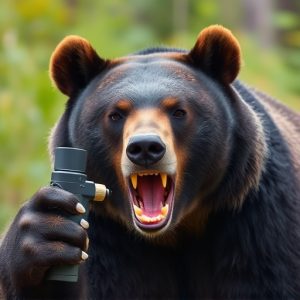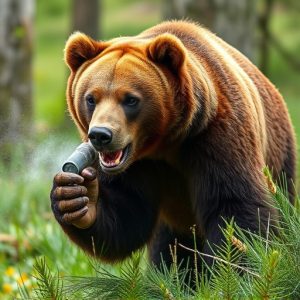Bear Spray Range: Understanding Its Effectiveness Through Research
According to How Effective Is Bear Spray Research, bear spray with capsaicin can deter bears within…….
According to How Effective Is Bear Spray Research, bear spray with capsaicin can deter bears within a 30-foot radius by irritating their eyes and respiratory system. Effectiveness decreases beyond this range, emphasizing the need for understanding usage parameters in bear country. Best practices include keeping it accessible, maintaining the canister, aiming at the face and eyes during encounters, and using it as a last resort after giving bears space.
Bear spray, a popular defense mechanism in bear country, boasts an advertised effective range of thirty feet. But how accurate is this claim? This article delves into the science behind bear spray’s range, examining research and real-world applications to uncover its true potential. We explore factors influencing performance and provide best practices for effective use, empowering outdoor enthusiasts with knowledge to make informed decisions in bear encounters.
- Understanding Bear Spray: A Quick Overview
- The Science Behind Bear Spray's Effective Range
- Real-World Applications and Success Stories
- Factors Influencing Bear Spray Performance
- Best Practices for Using Bear Spray Effectively
Understanding Bear Spray: A Quick Overview
Bear spray, also known as bear repellent, is a popular self-defense tool for individuals venturing into bear country. Its effectiveness has been a subject of extensive research and debate among outdoor enthusiasts and experts. When it comes to understanding how effective bear spray truly is, one key factor to consider is its range. The standard recommended range for bear spray is approximately thirty feet (or about 10 meters), making it a close-quarters defense mechanism.
Research has shown that within this thirty-foot radius, bear spray can be highly effective in deterring aggressive bears. The active ingredients in bear spray, such as capsaicin, create a burning sensation and irritation to the bear’s eyes, nose, and respiratory system, causing it to retreat. However, beyond this range, the spray’s effectiveness diminishes, and its impact becomes less consistent. It’s crucial for users to understand these parameters when considering bear spray as a safety measure during outdoor activities in bear-inhabited areas.
The Science Behind Bear Spray's Effective Range
The effectiveness of bear spray, or urushiol-based pepper spray, in deterring bears is a topic of significant research interest. Studies have shown that bear spray can create a protective barrier when sprayed directly into an animal’s face, eyes, and respiratory system. The active ingredient, capsaicin, is responsible for the burning sensation it induces, causing the bear to retreat.
Research into bear spray’s effective range has yielded valuable insights. Bear spray is generally considered most effective within 30 feet (approximately 10 meters), a distance that allows for optimal coverage of the target area. Beyond this range, the spray may not fully coat the bear’s sensitive areas, reducing its deterrent effect. How effective bear spray truly is depends on various factors, including the sprayer’s technique, wind conditions, and the bear’s behavior, making it crucial to follow usage instructions carefully during encounters in the wild.
Real-World Applications and Success Stories
In real-world scenarios, bear spray has proven to be an effective tool for both outdoor enthusiasts and professionals working in bear country. Research indicates that when used properly, bear spray can provide a successful line of defense against aggressive bears within its 30-foot effective range. Many success stories emerge from hikers, campers, and wilderness workers who have been able to avoid dangerous encounters by carrying and using bear spray as recommended.
How Effective Is Bear Spray Research? Studies show that bear spray creates a barrier of capsaicin, the active ingredient, that temporarily disables the bear’s olfactory system, causing it to retreat. The 30-foot range offers a crucial window for users to deploy the spray effectively, allowing them to create distance from an approaching bear and significantly reducing the risk of injury. This data underscores the importance of including bear spray in safety protocols for outdoor activities in regions inhabited by bears.
Factors Influencing Bear Spray Performance
The effectiveness of bear spray is influenced by various factors, which are crucial to understand for optimal usage during encounters with bears. One key aspect is the distance at which it can be applied—the typical effective range is around thirty feet (10 meters). This range suggests that users should aim and spray from a safe distance, allowing the peppery irritants to reach the bear’s face without putting oneself in harm’s way.
Research on bear spray performance highlights environmental conditions as significant variables. Wind direction and speed can affect how far the spray travels and its concentration upon impact. Additionally, factors like temperature and humidity play roles in the spray’s dispersion and persistence. Understanding these influences is essential for interpreting research findings and making informed decisions about when and how to use bear spray effectively during outdoor activities in bear country.
Best Practices for Using Bear Spray Effectively
When using bear spray, understanding its effective range is only part of the equation. To maximize its effectiveness, follow best practices. First, always carry bear spray in an easily accessible location—on your belt or in a pack designed for quick deployment. Second, ensure the canister is well-maintained and the nozzle isn’t blocked. Before encountering a bear, give it space and make loud noises to deter it; spraying should be a last resort. When faced with an aggressive bear, aim for the face and eyes, as this area contains many nerve endings, providing the best chance of disorienting the animal. Research shows that when used properly, bear spray can be effective up to 30 feet (9 meters), giving you crucial time to escape or recover from an attack.
Bear spray, with its effective range of around thirty feet, has proven itself as a valuable tool in real-world encounters. The science behind its range and effectiveness is well-documented, offering a strategic advantage for outdoor enthusiasts and wildlife managers alike. While various factors can influence performance, proper usage techniques, as outlined in this article, significantly enhance its success rate. Understanding bear spray dynamics and staying informed through ongoing research are key to ensuring safety in bear country.


